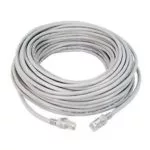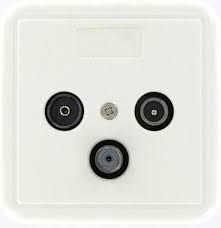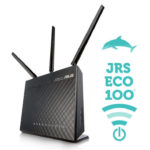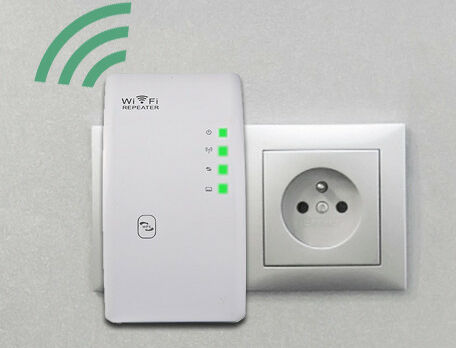Is a wifi booster/repeater/extender a good idea in terms of radiation?
Is a wifi booster, also called a wifi range extender, a good idea for improving wireless reception in the home? We don’t think so, and in this article we present 3 low radiation alternatives.
Due to working at home and the children learning at home, the demand for wifi within the home has recently increased dramatically. The question we often get is: how can I improve wifi range in my home in a low radiation manner?
First and foremost, we always say: ‘hardwired’ is the best, because it’s radiation free. Did you know that you can even connect an iPad and iPhone to the internet with a cable? The reality though is that a lot of people still want to use wifi in their home.
The range of a wifi router depends on the building materials of your home. For example, reinforced concrete walls and ceilings reduce the wifi signal, while the signal passes through wood almost unhindered.
The problem with wifi boosters
It’s so easy to plug in a wifi extender, which amplifies the wifi signal at the 2nd point so that your internet reaches further. But is this a good idea in terms of radiation and are there other solutions?
With a wifi booster you get, as it were, a second very strong router in your home. The problem is: besides a good wifi connection, it gives a lot of extra high-frequency radiation: 10 pulses per second, 24 hours a day.
(If you take the radiation exposure for granted and want to continue using wifi boosters, make sure the distance between your workspace and the wifi booster is as large as possible. Unplug it at night and turn off the wifi on your devices at night).
There are better solutions.
The problem with powerline adapters
There is another solution, the powerline / PLC adapters. These work with a signal at 2-30 Megahertz that is put on the existing power wires in your home. However, this wiring was never meant for this purpose and acts as a kind of antenna, because it is not shielded, and radiates the signal around your house. Sometimes amateur broadcasters even complain about interference from their neighbor’s powerline adapters. Therefore, powerline adapters are not radiation-free.
There are also combinations of wifi booster + powerline adapter, which means you end up with both of the above problems.
For the above reasons, you can try to improve range using the following ways.
1. Set the built-in wifi in your Internet modem/router to a free channel
First of all you can check if it’s possible to set the built-in wifi in your Internet modem/router – that’s the box you got from e.g. Comcast or Verizon – to a free channel. It’s getting busier and busier in the air and that results in a cacophony of wifi-routers, all talking together. You can avoid this interference from the neighbors’ routers by putting your own router on a free channel, so that your own wifi signal is ‘better audible’ to your wireless devices. Instructions on how to do this for the Eco router are here. This way, your wifi reaches further. Then you might not even need a wifi-repeater at all at a 2nd point. If this succeeds, it is the most elegant solution, where you do not need any new equipment. If necessary, ask a technically handy person or your provider for help. If this is not a solution for your situation, then continue below.
2. Run an Ethernet cable to the 2nd point and place a JRS Eco router there
 The second best solution is: pull an Ethernet cable to the second point where you want wifi and put a JRS Eco router there. See below for more details.
The second best solution is: pull an Ethernet cable to the second point where you want wifi and put a JRS Eco router there. See below for more details.
But in my house it’s difficult to pull LAN/Ethernet cables…
What if laying cables is not an option?
3. Use the existing coaxial TV cables in your home
 Many homes still have coaxial TV cables throughout the house. The connections are those round holes in the wall, as you can see in the picture here. Coincidence has it that these coax cables happen to be excellent conductors for an internet signal! Coax TV cables are shielded and radiation free. This allows you to enjoy high speed hardwired internet throughout your house without having to pull additional cables.
Many homes still have coaxial TV cables throughout the house. The connections are those round holes in the wall, as you can see in the picture here. Coincidence has it that these coax cables happen to be excellent conductors for an internet signal! Coax TV cables are shielded and radiation free. This allows you to enjoy high speed hardwired internet throughout your house without having to pull additional cables.
Do you have this coax cabling in your home? Then you can plug in a MoCa Ethernet over Coax network adapter near your Internet modem/router, and it will transmit the Internet signal over the existing coax cables in your home. Plug in a second MoCa adapter at the 2nd point and the connection is set up. In short: a stable, robust and ultra-fast 1 Gigabit/s connection that you can easily install yourself.
The low radiation JRS Eco router
To get a super-low radiation wifi, you put a JRS Eco router on the 2nd location. The advantages of the latest JRS Eco 100 wireless router are:
 100% radiation-free on standby. No wifi radiation when your wireless devices are switched off. Switches on immediately when one of your own devices requires a wifi connection.
100% radiation-free on standby. No wifi radiation when your wireless devices are switched off. Switches on immediately when one of your own devices requires a wifi connection.- 90% reduced pulse rate when wifi is turned on. So even when the wifi is active, the Eco router emits less radiation than a regular router.
- Wifi scheduler: set times at which wifi is automatically turned off, for example at night.
While you’re at it, we recommend you finish the job and also deal with the wifi radiation at the 1st point. The built-in wifi of your internet modem-/router also emits a lot of radiation: 10 pulses per second, 24 hours a day. Turn this built-in wifi off, or have it done by a technically skilled person or your provider. Then also place an Eco router, next to your internet modem / router, and connect it using the included network cable. The Eco router will then take care of the wifi at this point, so you also have low radiation wifi at the 1st point. In our video you can see exactly how it works:
Questions? Contact us
See also I have a large house. How can I make sure I have Internet everywhere?



